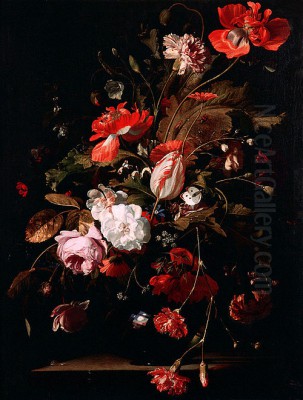
Willem van Aelst stands as a significant figure in the rich tapestry of Dutch Golden Age painting. Active during the Baroque period, he dedicated his considerable talents primarily to the genre of still life, achieving renown for his exquisite depictions of flowers, fruit, and hunting trophies. Born into a notable family in Delft, his life and career spanned a dynamic era in European art, marked by extensive travel, prestigious patronage, and a lasting influence on subsequent generations of artists. His work continues to be celebrated for its technical brilliance, sophisticated compositions, and the subtle interplay of light and texture.
Early Life and Artistic Foundations in Delft
Willem van Aelst was born in Delft, a prominent center for the arts in the Dutch Republic, around 1626 or 1627. His family held a respectable position in the city; his father served as a notary or judge. Crucially for his future path, Willem was the nephew of Evert van Aelst (1602-1657), himself a painter. While Evert is noted for landscapes, he also practiced still life painting, and it was under his tutelage that the young Willem received his initial artistic training. This familial connection provided an early immersion into the world of art and likely shaped his inclination towards the meticulous observation required for still life.
Demonstrating early promise, Willem van Aelst formally entered the professional sphere of artists by joining the Guild of Saint Luke in Delft in 1643. Membership in the guild was essential for artists wishing to practice independently, take on pupils, or sell their work within the city. This step marked the official commencement of his career as a painter, setting the stage for his future accomplishments both within the Netherlands and abroad. His early works from this period likely reflected the established traditions of Delft still life painting, while hinting at the individual style he would later develop.
The Grand Tour: France and Italy
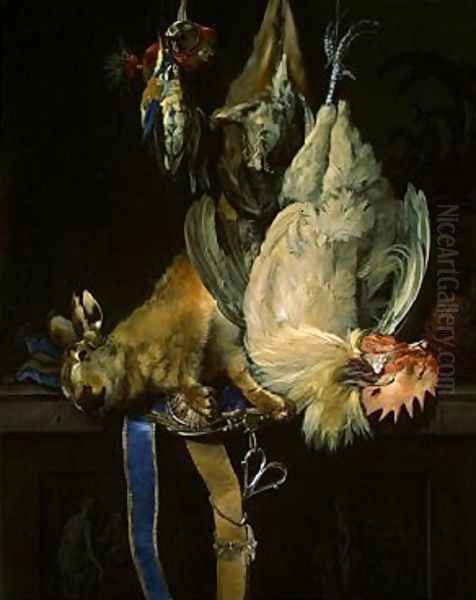
Like many ambitious artists of his time, Van Aelst embarked on travels beyond the borders of the Dutch Republic to broaden his horizons and seek new opportunities. Around 1645, he journeyed first to France, spending time absorbing the artistic currents there. Following his stay in France, he traveled onwards to Italy, the ultimate destination for artists seeking inspiration from classical antiquity and the masters of the Renaissance and Baroque. He remained in Italy for a significant period, approximately from the mid-1640s until 1651.
His time in Italy proved exceptionally fruitful, particularly his stay in Florence. There, he entered the service of the influential Ferdinando II de' Medici, Grand Duke of Tuscany. This prestigious appointment as a court painter signifies the high regard in which his talent was held. The Medici court was a center of artistic patronage, and working for the Grand Duke provided Van Aelst not only with financial stability but also with access to elite circles and important collections. His service was evidently appreciated, as he was rewarded by the Grand Duke with a gold medal and a valuable gold chain, tokens of exceptional favour and recognition.
During his Italian sojourn, Van Aelst interacted with fellow artists, including other Dutch and Flemish painters working abroad. Notably, he formed connections with Matthias Withoos and Otto Marseus van Schrieck, both fellow Dutchmen specializing in still life, particularly the sottobosco (forest floor) genre. They worked together in Florence, and it is likely that they exchanged ideas and influenced each other's styles. Some sources suggest Van Aelst might have been an assistant or even a student of Schrieck during this period, highlighting the collaborative and educational environment among expatriate artists. There is also speculation, though unproven, that Van Aelst might have had connections with the Bentvueghels, a society of primarily Dutch and Flemish artists active in Rome, possibly indicated by a unique signature element he used briefly after his return.
The Italian experience significantly impacted Van Aelst's art. He absorbed the elegance and refinement characteristic of Italian taste, which he integrated into his Dutch sensibilities. His compositions became more complex, his handling of light more dramatic, and his subject matter often reflected the luxurious items favoured by aristocratic patrons. His success in securing commissions from Italian collectors further attests to his ability to adapt and appeal to an international audience. Questions surrounding his religious identity also arise from this period; while his background was likely Protestant, his close association with the Catholic court in Florence has led some to speculate, without definitive proof, that he might have converted to Catholicism.
Return to the Netherlands: The Amsterdam Years
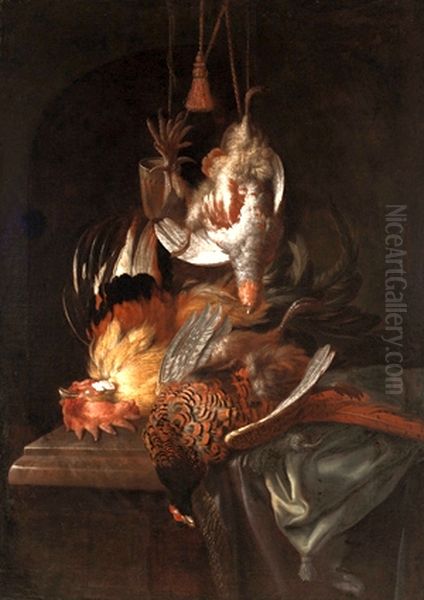
In 1656, Willem van Aelst returned to the Netherlands, bringing with him the skills, reputation, and continental flair acquired during his years abroad. After a brief period, possibly back in Delft, he made a decisive move in 1657, settling in Amsterdam. At this time, Amsterdam was the bustling commercial and cultural heart of the Dutch Republic, offering greater opportunities for patronage and artistic success than Delft.
His arrival in Amsterdam marked the beginning of the most mature and arguably most successful phase of his career. He quickly established himself as one of the city's leading still life painters, his sophisticated style finding favour with the wealthy merchant class and connoisseurs. His paintings, known for their elegance, technical perfection, and often luxurious subject matter, commanded high prices, reflecting his esteemed status in the competitive Amsterdam art market.
Beyond his own prolific output, Van Aelst became an influential teacher in Amsterdam. He took on several pupils who would go on to achieve considerable fame in their own right. Among his most notable students were Rachel Ruysch and Maria van Oosterwyck, both of whom became highly successful flower painters, carrying forward elements of his meticulous technique and compositional elegance. Another known pupil was Isaac Denies. His role as a teacher underscores his importance not just as a creator but also as a transmitter of artistic knowledge and style. An anecdote concerning his relationship with Rachel Ruysch suggests a demanding master; he reportedly required her to cease contact for a year and dedicate ten hours daily to studio work, indicating his rigorous approach to artistic training.
Despite his eventual success and the high prices his works fetched, historical records suggest Van Aelst may have faced periods of financial difficulty. Evidence indicates he sometimes adapted his production strategies, perhaps creating works of varying sizes or occasionally using less expensive materials to navigate economic pressures. However, by the later stages of his career in Amsterdam, he had secured a prominent and respected position within the art world. He continued to paint actively until his death in Amsterdam around 1683, leaving behind a significant body of work.
Artistic Style and Technical Mastery
Willem van Aelst's art is characterized by its refinement, technical virtuosity, and adherence to the broader aesthetics of the Baroque period, albeit with a distinctly Dutch focus on realism and detail. His primary domain was still life, encompassing floral arrangements, fruit displays, and particularly hunting still lifes (jachtstukken). Within these genres, he developed a signature style marked by several key features.
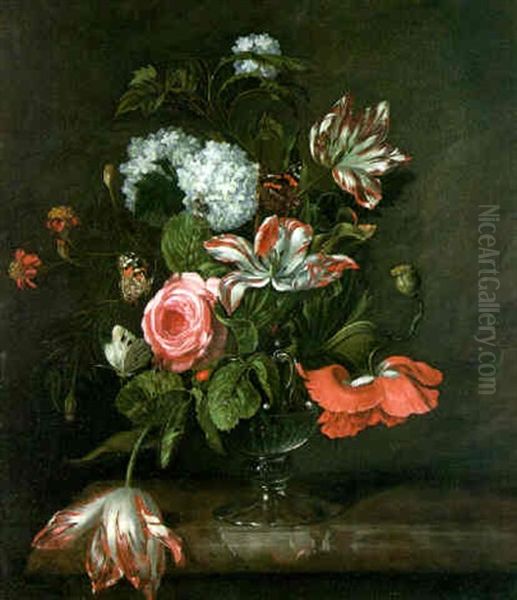
His technique was exceptionally meticulous. Van Aelst possessed an extraordinary ability to render textures convincingly, differentiating between the soft bloom on a grape, the cool smoothness of a silver platter, the delicate fragility of glass, the rich nap of velvet drapery, and the varied textures of feathers and fur in his game pieces. This tactile quality invites the viewer to almost feel the objects depicted. His brushwork is often highly controlled and barely visible, contributing to the illusionistic realism of his paintings.
Compositionally, Van Aelst favoured arrangements that were both complex and elegant. He often employed asymmetrical designs, using diagonal lines created by objects like hunting horns, rifles, or strategically placed flowers to create a sense of dynamism and depth. His compositions feel carefully constructed yet avoid rigid formality, often incorporating a sense of graceful movement or casual arrangement, particularly in his later works. He frequently used dark, atmospheric backgrounds, which served to highlight the illuminated objects in the foreground.
The handling of light and shadow (chiaroscuro) is central to Van Aelst's style. He masterfully used light not only to model form and create a sense of three-dimensionality but also to enhance the drama and mood of the scene. Often, a focused light source illuminates the central objects, allowing them to emerge vividly from the surrounding darkness. Reflections on glass and metal surfaces are rendered with particular brilliance, showcasing his skill in capturing the interplay of light. This use of light contributes significantly to the depth and realism, as well as the often mysterious or luxurious atmosphere of his paintings. His colour palette was typically rich and harmonious, employing deep reds, blues, and greens, often set off against subtle neutral tones.
Subject Matter, Symbolism, and Themes
Van Aelst's oeuvre primarily consists of several types of still life. Flower paintings were a staple, showcasing his ability to capture the delicate beauty and transient nature of blooms. He often depicted arrangements in ornate vases, combining cultivated flowers with wildflowers and sometimes insects, adhering to a tradition popularized by artists like Jan Davidsz. de Heem. Fruit still lifes were another common subject, featuring arrangements of grapes, peaches, and other fruits, often accompanied by glassware, silverware, and rich textiles, reflecting the prosperity of the Dutch Golden Age.
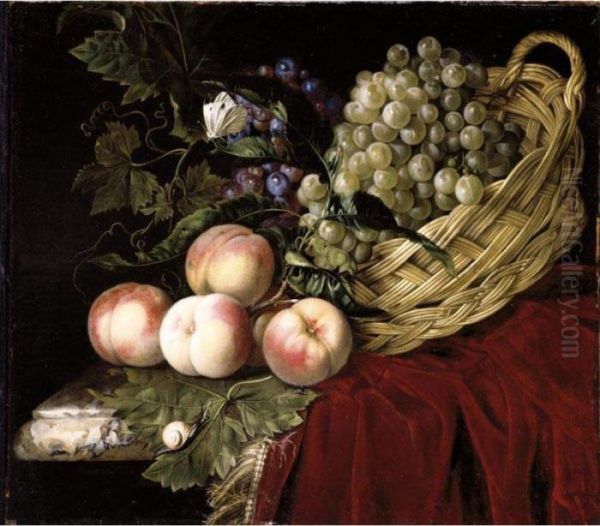
He gained particular renown for his hunting still lifes, or jachtstukken. These paintings typically depict dead game birds (partridges, ducks, etc.) and sometimes hares, often suspended from hooks or arranged alongside hunting equipment such as horns, powder flasks, and game bags. These works appealed to the aristocratic and wealthy burgher tastes of the time, symbolizing status, leisure, and the bounty of nature. The meticulous rendering of feathers and fur in these paintings is a testament to his observational skills.
Beyond the surface beauty and technical display, Van Aelst's still lifes often carry deeper symbolic meanings, aligning with the vanitas tradition prevalent in Dutch art. While celebrating abundance and worldly possessions, these paintings frequently include elements that remind the viewer of the transience of life and the inevitability of death. Wilting flowers, decaying fruit, snuffed candles, timepieces (like pocket watches), and skulls (though less common in Van Aelst than in some contemporaries like Pieter Claesz. or Willem Claesz. Heda) served as reminders of mortality. Insects, such as flies or butterflies, could symbolize decay or the fleeting nature of beauty. Even the luxurious objects themselves could be interpreted as representing the vanity of earthly pleasures. This layering of meaning added intellectual depth to the visual appeal of his works.
Representative Works
Several paintings exemplify Willem van Aelst's style and favoured subjects:
Flower Still Life (numerous examples, e.g., 1663, Mauritshuis, The Hague): These works showcase his ability to create elegant, asymmetrical bouquets featuring a variety of flowers rendered with botanical accuracy and exquisite detail. The interplay of light on petals and leaves, often set against a dark background, is characteristic.
Still Life with Dead Game or Hunting Trophies (various dates and collections, e.g., c. 1660-1670s): These paintings are perhaps his most distinctive contribution. They typically feature suspended game birds, rendered with astonishing realism, alongside hunting paraphernalia. The textures of feathers, the gleam of a hunting horn, and the richness of velvet or silk drapery are hallmarks. Examples can be found in the Rijksmuseum, Amsterdam, and the Wallace Collection, London.
Fruit Still Life with Mouse (e.g., 1677): Displays of fruit, often peaches and grapes known for their symbolic associations, arranged with fine glassware or silverware on a draped table. The inclusion of a mouse adds a touch of naturalism and potentially symbolic meaning (related to decay or gluttony).
Still Life with Nautilus Cup (e.g., 1678, Museo Thyssen-Bornemisza, Madrid): Depictions of luxurious objects, such as the exotic nautilus shell mounted in ornate silver-gilt, were popular subjects for pronkstilleven (ostentatious still lifes). Van Aelst excelled at capturing the reflective surfaces and intricate details of such precious items, showcasing both the wealth of his patrons and his own technical skill. These works often carry strong vanitas undertones.
These examples highlight the recurring themes, compositional strategies, and technical brilliance that define Van Aelst's contribution to still life painting.
Influences, Contemporaries, and Legacy
Willem van Aelst's artistic development was shaped by several influences. His initial training came from his uncle, Evert van Aelst. During his time in Italy, his interactions with Otto Marseus van Schrieck and Matthias Withoos were significant, likely influencing his handling of light and perhaps his interest in detailed natural elements. Upon his return to the Netherlands, particularly in Amsterdam, he entered a vibrant artistic milieu.
He was a contemporary of other major Dutch still life painters. Jan Davidsz. de Heem, known for his opulent floral and fruit still lifes, was a leading figure whose work shows parallels in complexity and richness. Willem Kalf, also active in Amsterdam, was renowned for his pronkstilleven featuring luxurious objects; indeed, attribution issues have sometimes arisen between Van Aelst and Kalf, indicating a similarity in quality and subject matter, with some works previously attributed to Van Aelst now given to Kalf. Other important contemporaries in the broader field of still life include Pieter Claesz. and Willem Claesz. Heda (masters of the monochrome banketje or breakfast piece), Abraham van Beijeren (known for lavish banquet scenes and fish still lifes), and later flower painters like Jan van Huysum, who built upon the traditions established by Van Aelst's generation.
Van Aelst's own influence was considerable, primarily through his students. Rachel Ruysch and Maria van Oosterwyck became leading figures in flower painting, achieving international fame and demonstrating the enduring appeal of the detailed, elegant style championed by their master. His sophisticated compositions and refined technique set a high standard and contributed to the evolution of still life painting in the later Dutch Golden Age and beyond into the 18th century.
Historically, Van Aelst has consistently been evaluated as one of the most accomplished and refined still life painters of his era. His works were highly sought after during his lifetime by prestigious patrons like the Medici and Dutch collectors, and they have remained prized possessions in major museums worldwide, including the Rijksmuseum in Amsterdam, the Mauritshuis in The Hague, the Metropolitan Museum of Art in New York, and many others. His paintings are admired for their technical perfection, aesthetic elegance, and the subtle blend of realism and symbolism.
Conclusion
Willem van Aelst carved a distinct and distinguished niche within the celebrated tradition of Dutch Golden Age still life painting. From his early training in Delft to his formative years in Italy and his mature career in Amsterdam, he cultivated a style characterized by exquisite detail, sophisticated composition, masterful handling of light and texture, and an elegant sensibility. Whether depicting opulent flower arrangements, arrangements of fruit and luxurious objects, or his renowned hunting trophies, his work consistently displays technical brilliance and aesthetic refinement. As both a highly successful painter and an influential teacher, Van Aelst left an indelible mark on the history of art, and his paintings continue to captivate viewers with their intricate beauty and quiet intensity, securing his place as a true master of the genre.